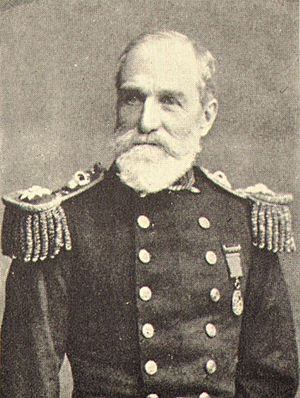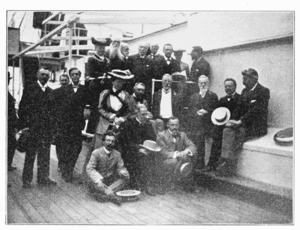William Wharton (Royal Navy officer) facts for kids
Quick facts for kids
Sir William Wharton
|
|
|---|---|
 |
|
| Born | 2 March 1843 London |
| Died | 29 September 1905 (aged 62) Cape Town, South Africa |
| Allegiance | |
| Service/ |
|
| Years of service | 1857 - 1904 |
| Rank | Rear Admiral |
| Commands held | HMS Shearwater HMS Fawn HMS Sylvia |
| Awards | Knight Commander of the Bath (1897) Fellow of the Royal Society (1886) |
| Office | Hydrographer of the Navy |
| Term | 1884-1904 |
Admiral Sir William James Lloyd Wharton was a brave British admiral and a very important person called the Hydrographer of the Navy. This job meant he was in charge of making maps of the seas for the Royal Navy. He was born in London on March 2, 1843, and passed away in Cape Town, South Africa, on September 29, 1905.
Contents
Who was William Wharton?
William Wharton was born in London. His father, Robert Wharton, was a judge. William went to school at Barney's Academy in Gosport and then to the Royal Naval Academy. This is where he began his journey to become a naval officer.
William Wharton joined the Royal Navy in August 1857. He quickly showed he was good at his job and became a lieutenant in 1863.
Early Surveying Work
Wharton's first job mapping the seas was on a ship called HMS Gannet. He worked in the Bay of Fundy, which is famous for having some of the highest tides in the world. Mapping these waters was very difficult because the water levels changed so much.
In 1870, he was part of a team on HMS Urgent. They traveled to Gibraltar to watch a total eclipse of the sun. This was important for science at the time.
Leading Expeditions
Wharton became a commander in 1872. As captain of Shearwater, he mapped large areas of the Sea of Marmora and the Bosphorus. He also surveyed parts of the Mediterranean Sea and the Indian Ocean. In the Bosphorus, he found clever ways to measure how water flowed at different depths. This showed that currents could flow in opposite directions at the same time.
In 1874, Wharton helped prepare for a special event called the first transit of Venus. This is when the planet Venus passes directly in front of the sun. He helped move many special clocks called chronometers to different places in the Indian Ocean. These clocks helped scientists figure out the exact locations of their observation stations. He worked with an astronomer named David Gill, who became a good friend. This work helped to accurately map the Seychelles islands, which Wharton later used for his mapping work in Africa.
From 1876, as captain of Fawn, he continued to map the seas off East Africa. He became a captain in 1880. For the next two years, he wrote a book called Hydrographic Surveying, which was a guide for mapping the seas.
In 1882, he was put in charge of HMS Sylvia to do more mapping in South America. While there, he observed the second transit of Venus in December 1882.
On August 1, 1884, William Wharton was given a very important job: Hydrographer of the Navy. He held this position for twenty years! In this role, he was responsible for all the sea charts and maps used by the British Navy. In 1895, he was promoted to rear-admiral.
Awards and Recognition
William Wharton received several important awards for his work.
- He was made a Knight Commander of the Bath in 1897 during the Queen's Diamond Jubilee. This meant he was given the title "Sir."
- He was also chosen to be a Fellow of the Royal Society in 1886. This is a very high honor for scientists.
- He was also a member of the Royal Geographical Society and the Royal Astronomical Society.
His Final Years
In 1905, the British Association held a meeting in South Africa. William Wharton, who was the President of the Geographic Section, traveled there to attend. Sadly, he became sick with a fever and passed away at the age of 62. He died at his friend David Gill's home in Cape Town.
To honor his important work, Mount Wharton in Antarctica and the Wharton Basin in the Indian Ocean were named after him.
Images for kids






